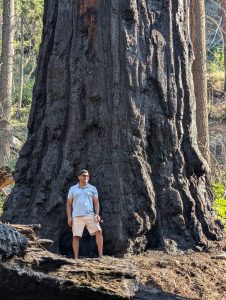
This summer I ticked off one item on my bucket-list – walking among ancient giants. I am talking about the Giant Forest at the Sequoia National Park ensconced high up in the southern Sierra Nevada in California. Growing up to 250 feet in height, 25 feet in diameter and an average age of 1600 years, these marvels of nature are an amazing visage to behold.
But more remarkable to me is their resilience to forest fires this region is notorious for. Giant sequoias grow in high altitudes that provides the dry air and well-drained soil it needs. That also is a recipe for forest fires. Recognizing the challenges of the environment they must grow in, young sequoias rapidly grow in height to where most fires cannot reach its boughs and then it protects its base by growing a spongy bark that can be up to 18 inches thick that insulates the tree from heat and from being consumed by fire. Their mountainous, rocky habitat results in shallow roots vs. the deep taproot large trees typically rely on for anchoring and tapping into ground water.
So, sequoias have a symbiotic relationship with each other, with shallow but intertwined roots that not only stabilize each other but also enable sharing of scarce moisture resources. And of course, should they end up being consumed by a fire that overwhelms its natural fortifications, they are masters of succession planning, using the heat to pop open their hard pine cones and release seeds that become new saplings in due time. These strategies have enabled these gentle giants to grow to tremendous heights, unfazed by the fiery turmoil their environment occasionally throws at them. Strategies that all of us can do good to bear in mind.
Learning from these gentle giants, we can draw valuable parallels for our own journeys:
The giant sequoias’ strategic adaptations serve as a powerful lesson in resilience for us all. #NatureInspiration #Resilience #StrategicPlanning #ResilientByDesign